Best Practices for Risk Management - PDF
VerifiedAdded on 2021/06/17
|15
|3296
|164
AI Summary
Contribute Materials
Your contribution can guide someone’s learning journey. Share your
documents today.
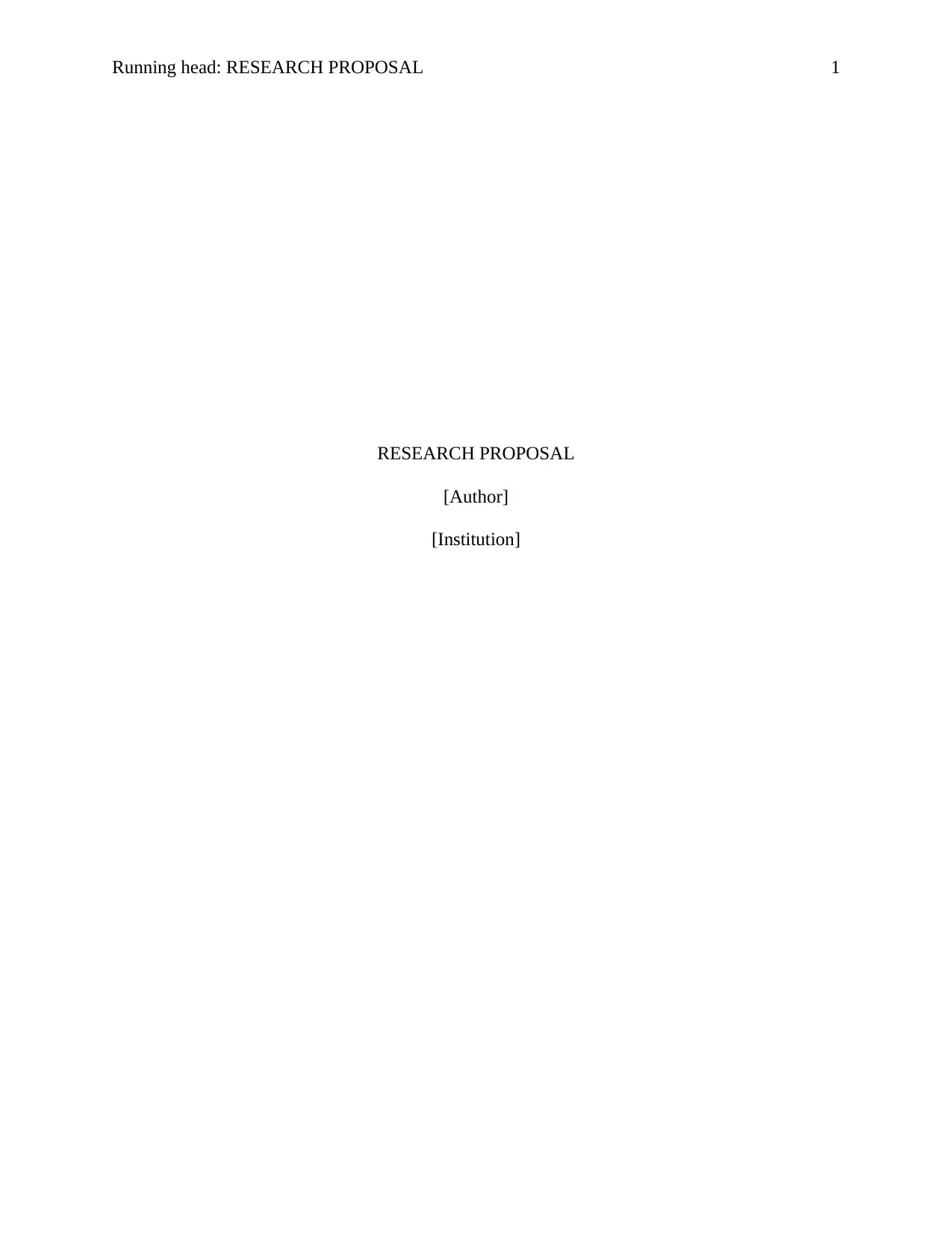
Running head: RESEARCH PROPOSAL 1
RESEARCH PROPOSAL
[Author]
[Institution]
RESEARCH PROPOSAL
[Author]
[Institution]
Secure Best Marks with AI Grader
Need help grading? Try our AI Grader for instant feedback on your assignments.
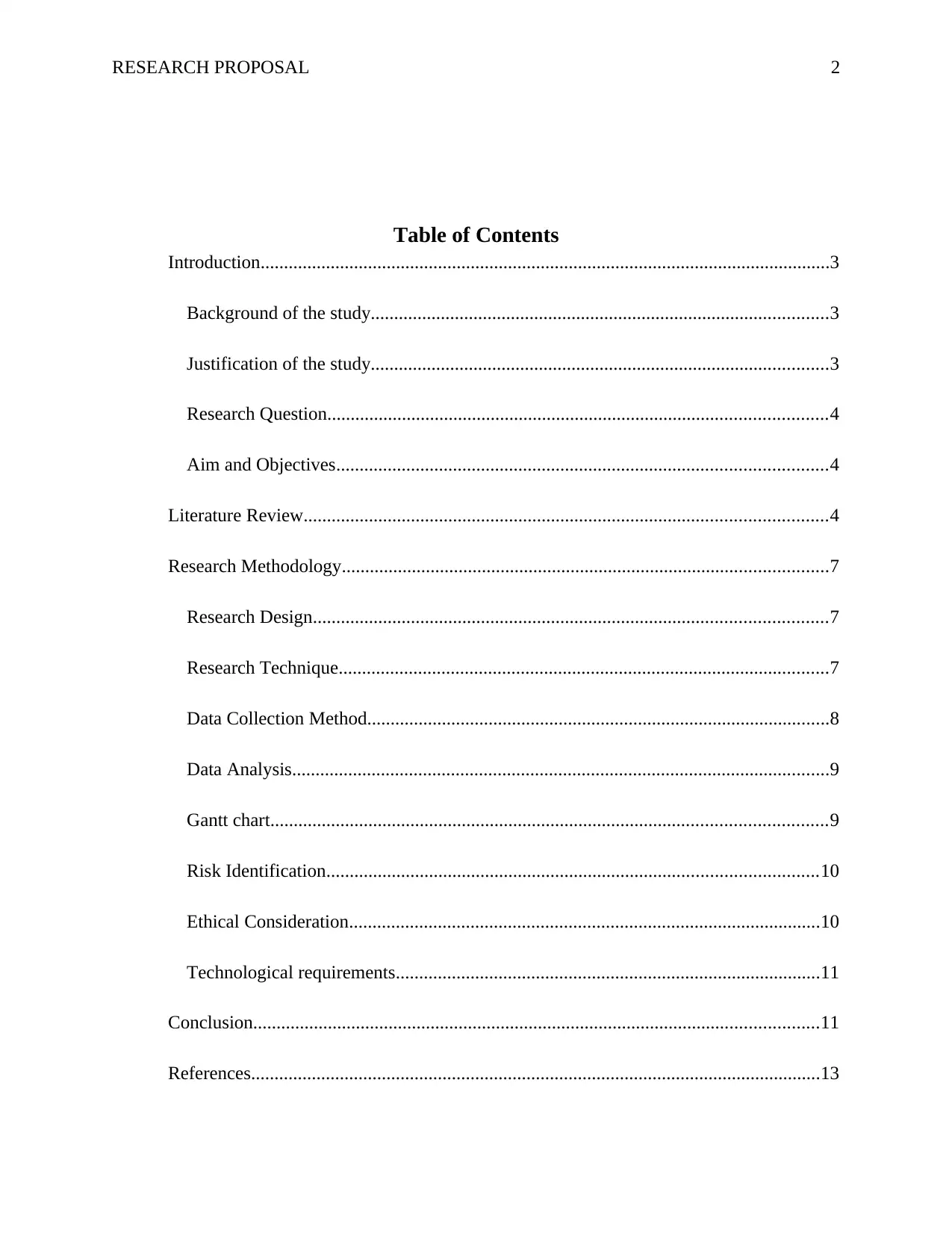
RESEARCH PROPOSAL 2
Table of Contents
Introduction..........................................................................................................................3
Background of the study..................................................................................................3
Justification of the study..................................................................................................3
Research Question...........................................................................................................4
Aim and Objectives.........................................................................................................4
Literature Review................................................................................................................4
Research Methodology........................................................................................................7
Research Design..............................................................................................................7
Research Technique.........................................................................................................7
Data Collection Method...................................................................................................8
Data Analysis...................................................................................................................9
Gantt chart.......................................................................................................................9
Risk Identification.........................................................................................................10
Ethical Consideration.....................................................................................................10
Technological requirements...........................................................................................11
Conclusion.........................................................................................................................11
References..........................................................................................................................13
Table of Contents
Introduction..........................................................................................................................3
Background of the study..................................................................................................3
Justification of the study..................................................................................................3
Research Question...........................................................................................................4
Aim and Objectives.........................................................................................................4
Literature Review................................................................................................................4
Research Methodology........................................................................................................7
Research Design..............................................................................................................7
Research Technique.........................................................................................................7
Data Collection Method...................................................................................................8
Data Analysis...................................................................................................................9
Gantt chart.......................................................................................................................9
Risk Identification.........................................................................................................10
Ethical Consideration.....................................................................................................10
Technological requirements...........................................................................................11
Conclusion.........................................................................................................................11
References..........................................................................................................................13
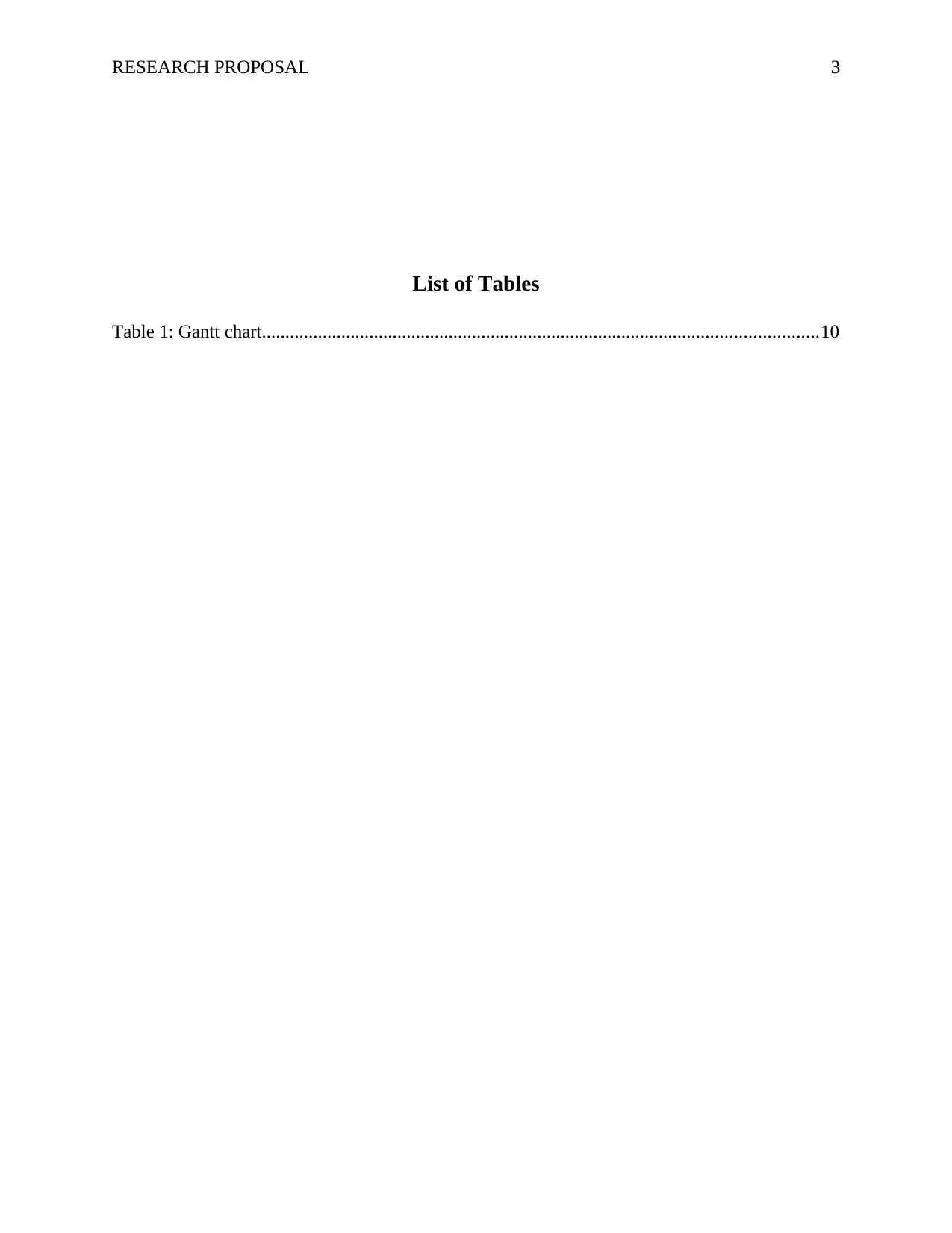
RESEARCH PROPOSAL 3
List of Tables
Table 1: Gantt chart.......................................................................................................................10
List of Tables
Table 1: Gantt chart.......................................................................................................................10
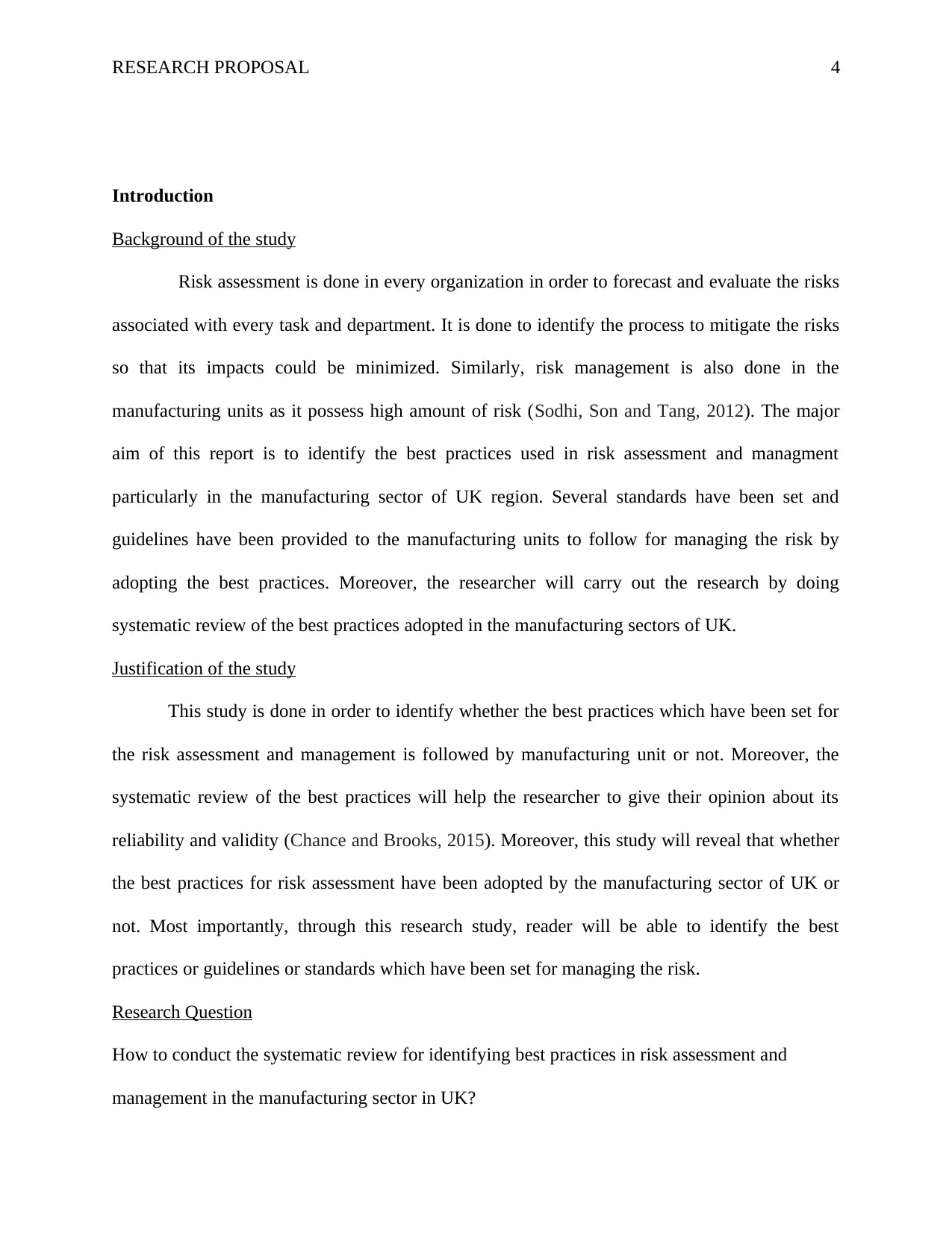
RESEARCH PROPOSAL 4
Introduction
Background of the study
Risk assessment is done in every organization in order to forecast and evaluate the risks
associated with every task and department. It is done to identify the process to mitigate the risks
so that its impacts could be minimized. Similarly, risk management is also done in the
manufacturing units as it possess high amount of risk (Sodhi, Son and Tang, 2012). The major
aim of this report is to identify the best practices used in risk assessment and managment
particularly in the manufacturing sector of UK region. Several standards have been set and
guidelines have been provided to the manufacturing units to follow for managing the risk by
adopting the best practices. Moreover, the researcher will carry out the research by doing
systematic review of the best practices adopted in the manufacturing sectors of UK.
Justification of the study
This study is done in order to identify whether the best practices which have been set for
the risk assessment and management is followed by manufacturing unit or not. Moreover, the
systematic review of the best practices will help the researcher to give their opinion about its
reliability and validity (Chance and Brooks, 2015). Moreover, this study will reveal that whether
the best practices for risk assessment have been adopted by the manufacturing sector of UK or
not. Most importantly, through this research study, reader will be able to identify the best
practices or guidelines or standards which have been set for managing the risk.
Research Question
How to conduct the systematic review for identifying best practices in risk assessment and
management in the manufacturing sector in UK?
Introduction
Background of the study
Risk assessment is done in every organization in order to forecast and evaluate the risks
associated with every task and department. It is done to identify the process to mitigate the risks
so that its impacts could be minimized. Similarly, risk management is also done in the
manufacturing units as it possess high amount of risk (Sodhi, Son and Tang, 2012). The major
aim of this report is to identify the best practices used in risk assessment and managment
particularly in the manufacturing sector of UK region. Several standards have been set and
guidelines have been provided to the manufacturing units to follow for managing the risk by
adopting the best practices. Moreover, the researcher will carry out the research by doing
systematic review of the best practices adopted in the manufacturing sectors of UK.
Justification of the study
This study is done in order to identify whether the best practices which have been set for
the risk assessment and management is followed by manufacturing unit or not. Moreover, the
systematic review of the best practices will help the researcher to give their opinion about its
reliability and validity (Chance and Brooks, 2015). Moreover, this study will reveal that whether
the best practices for risk assessment have been adopted by the manufacturing sector of UK or
not. Most importantly, through this research study, reader will be able to identify the best
practices or guidelines or standards which have been set for managing the risk.
Research Question
How to conduct the systematic review for identifying best practices in risk assessment and
management in the manufacturing sector in UK?
Secure Best Marks with AI Grader
Need help grading? Try our AI Grader for instant feedback on your assignments.
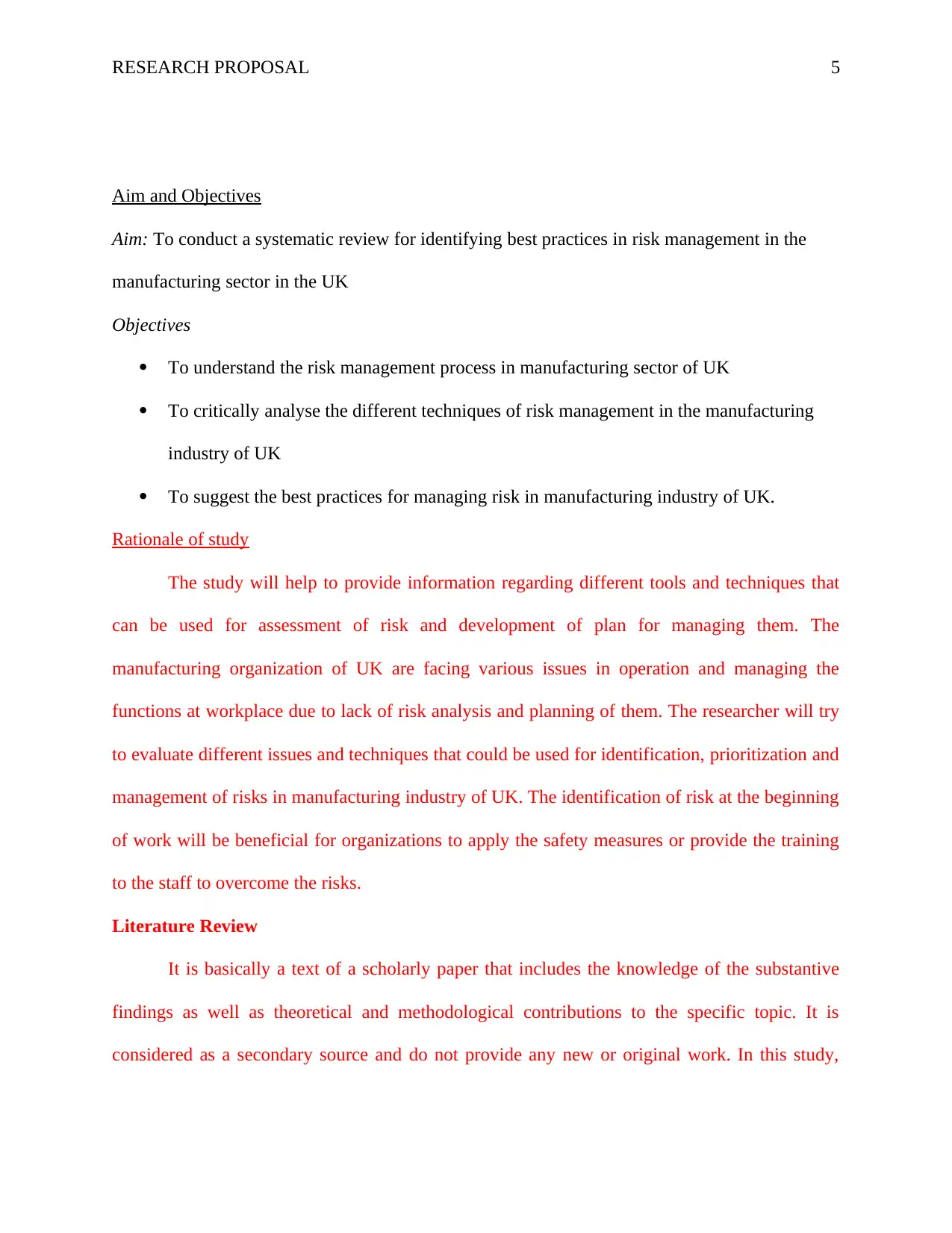
RESEARCH PROPOSAL 5
Aim and Objectives
Aim: To conduct a systematic review for identifying best practices in risk management in the
manufacturing sector in the UK
Objectives
To understand the risk management process in manufacturing sector of UK
To critically analyse the different techniques of risk management in the manufacturing
industry of UK
To suggest the best practices for managing risk in manufacturing industry of UK.
Rationale of study
The study will help to provide information regarding different tools and techniques that
can be used for assessment of risk and development of plan for managing them. The
manufacturing organization of UK are facing various issues in operation and managing the
functions at workplace due to lack of risk analysis and planning of them. The researcher will try
to evaluate different issues and techniques that could be used for identification, prioritization and
management of risks in manufacturing industry of UK. The identification of risk at the beginning
of work will be beneficial for organizations to apply the safety measures or provide the training
to the staff to overcome the risks.
Literature Review
It is basically a text of a scholarly paper that includes the knowledge of the substantive
findings as well as theoretical and methodological contributions to the specific topic. It is
considered as a secondary source and do not provide any new or original work. In this study,
Aim and Objectives
Aim: To conduct a systematic review for identifying best practices in risk management in the
manufacturing sector in the UK
Objectives
To understand the risk management process in manufacturing sector of UK
To critically analyse the different techniques of risk management in the manufacturing
industry of UK
To suggest the best practices for managing risk in manufacturing industry of UK.
Rationale of study
The study will help to provide information regarding different tools and techniques that
can be used for assessment of risk and development of plan for managing them. The
manufacturing organization of UK are facing various issues in operation and managing the
functions at workplace due to lack of risk analysis and planning of them. The researcher will try
to evaluate different issues and techniques that could be used for identification, prioritization and
management of risks in manufacturing industry of UK. The identification of risk at the beginning
of work will be beneficial for organizations to apply the safety measures or provide the training
to the staff to overcome the risks.
Literature Review
It is basically a text of a scholarly paper that includes the knowledge of the substantive
findings as well as theoretical and methodological contributions to the specific topic. It is
considered as a secondary source and do not provide any new or original work. In this study,
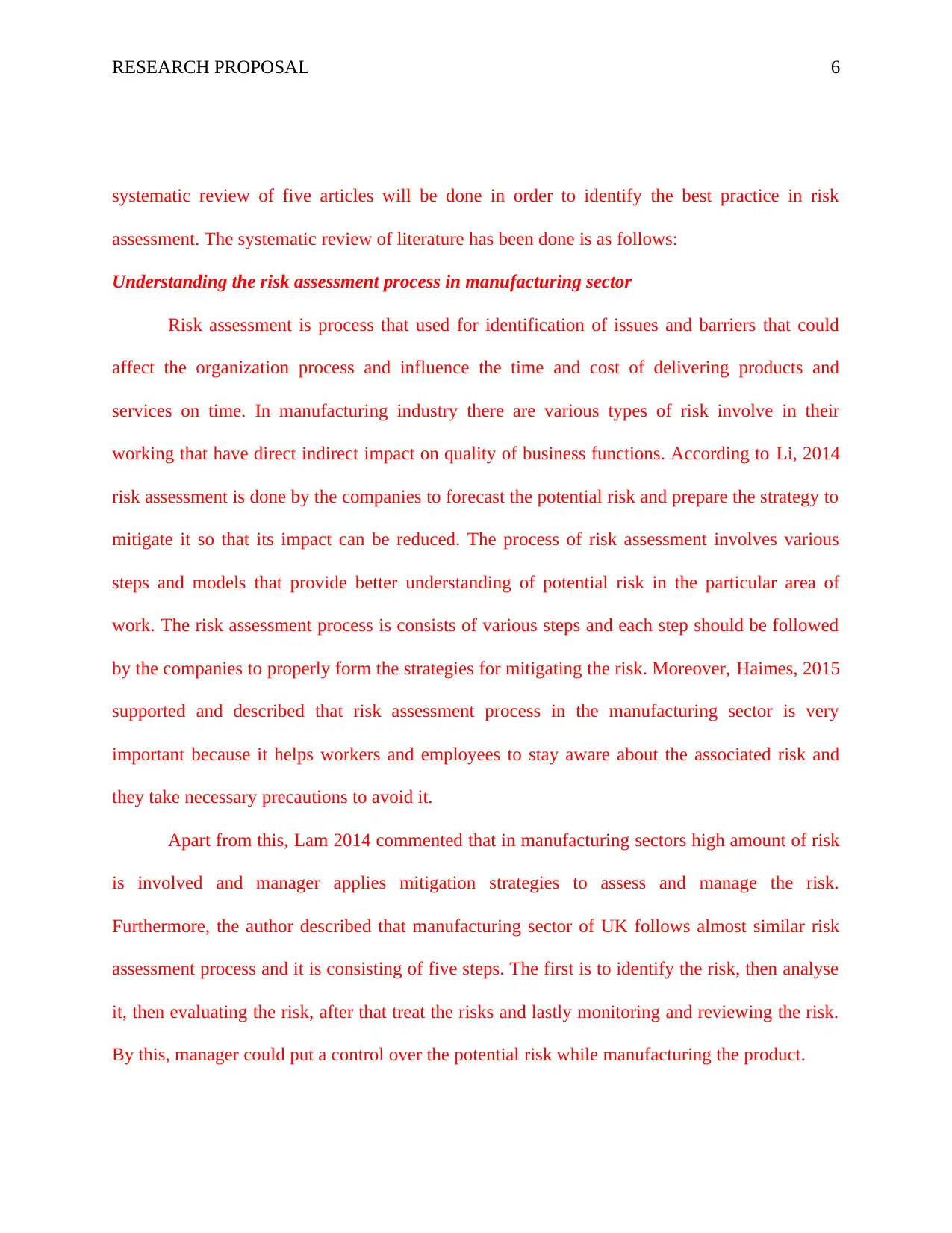
RESEARCH PROPOSAL 6
systematic review of five articles will be done in order to identify the best practice in risk
assessment. The systematic review of literature has been done is as follows:
Understanding the risk assessment process in manufacturing sector
Risk assessment is process that used for identification of issues and barriers that could
affect the organization process and influence the time and cost of delivering products and
services on time. In manufacturing industry there are various types of risk involve in their
working that have direct indirect impact on quality of business functions. According to Li, 2014
risk assessment is done by the companies to forecast the potential risk and prepare the strategy to
mitigate it so that its impact can be reduced. The process of risk assessment involves various
steps and models that provide better understanding of potential risk in the particular area of
work. The risk assessment process is consists of various steps and each step should be followed
by the companies to properly form the strategies for mitigating the risk. Moreover, Haimes, 2015
supported and described that risk assessment process in the manufacturing sector is very
important because it helps workers and employees to stay aware about the associated risk and
they take necessary precautions to avoid it.
Apart from this, Lam 2014 commented that in manufacturing sectors high amount of risk
is involved and manager applies mitigation strategies to assess and manage the risk.
Furthermore, the author described that manufacturing sector of UK follows almost similar risk
assessment process and it is consisting of five steps. The first is to identify the risk, then analyse
it, then evaluating the risk, after that treat the risks and lastly monitoring and reviewing the risk.
By this, manager could put a control over the potential risk while manufacturing the product.
systematic review of five articles will be done in order to identify the best practice in risk
assessment. The systematic review of literature has been done is as follows:
Understanding the risk assessment process in manufacturing sector
Risk assessment is process that used for identification of issues and barriers that could
affect the organization process and influence the time and cost of delivering products and
services on time. In manufacturing industry there are various types of risk involve in their
working that have direct indirect impact on quality of business functions. According to Li, 2014
risk assessment is done by the companies to forecast the potential risk and prepare the strategy to
mitigate it so that its impact can be reduced. The process of risk assessment involves various
steps and models that provide better understanding of potential risk in the particular area of
work. The risk assessment process is consists of various steps and each step should be followed
by the companies to properly form the strategies for mitigating the risk. Moreover, Haimes, 2015
supported and described that risk assessment process in the manufacturing sector is very
important because it helps workers and employees to stay aware about the associated risk and
they take necessary precautions to avoid it.
Apart from this, Lam 2014 commented that in manufacturing sectors high amount of risk
is involved and manager applies mitigation strategies to assess and manage the risk.
Furthermore, the author described that manufacturing sector of UK follows almost similar risk
assessment process and it is consisting of five steps. The first is to identify the risk, then analyse
it, then evaluating the risk, after that treat the risks and lastly monitoring and reviewing the risk.
By this, manager could put a control over the potential risk while manufacturing the product.
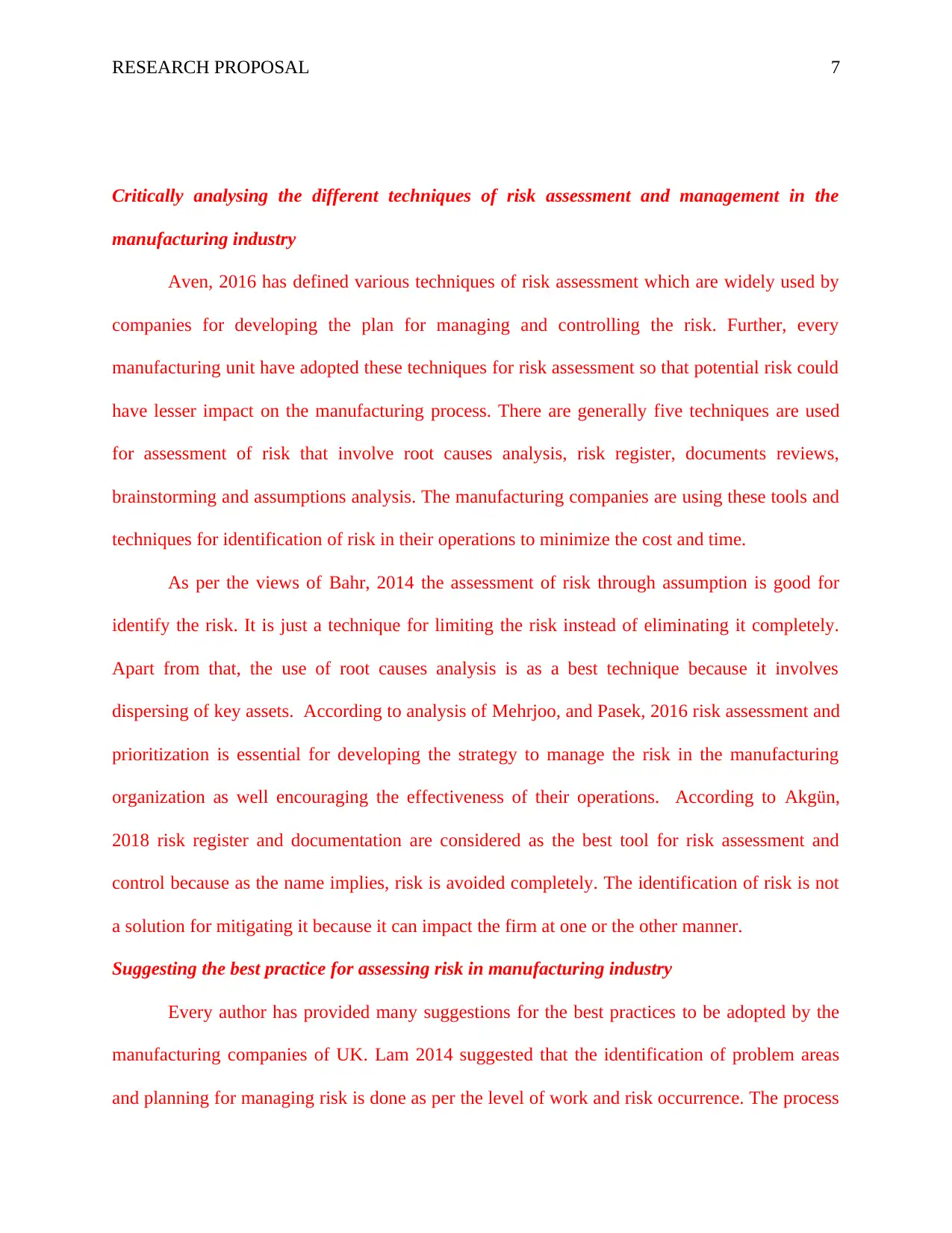
RESEARCH PROPOSAL 7
Critically analysing the different techniques of risk assessment and management in the
manufacturing industry
Aven, 2016 has defined various techniques of risk assessment which are widely used by
companies for developing the plan for managing and controlling the risk. Further, every
manufacturing unit have adopted these techniques for risk assessment so that potential risk could
have lesser impact on the manufacturing process. There are generally five techniques are used
for assessment of risk that involve root causes analysis, risk register, documents reviews,
brainstorming and assumptions analysis. The manufacturing companies are using these tools and
techniques for identification of risk in their operations to minimize the cost and time.
As per the views of Bahr, 2014 the assessment of risk through assumption is good for
identify the risk. It is just a technique for limiting the risk instead of eliminating it completely.
Apart from that, the use of root causes analysis is as a best technique because it involves
dispersing of key assets. According to analysis of Mehrjoo, and Pasek, 2016 risk assessment and
prioritization is essential for developing the strategy to manage the risk in the manufacturing
organization as well encouraging the effectiveness of their operations. According to Akgün,
2018 risk register and documentation are considered as the best tool for risk assessment and
control because as the name implies, risk is avoided completely. The identification of risk is not
a solution for mitigating it because it can impact the firm at one or the other manner.
Suggesting the best practice for assessing risk in manufacturing industry
Every author has provided many suggestions for the best practices to be adopted by the
manufacturing companies of UK. Lam 2014 suggested that the identification of problem areas
and planning for managing risk is done as per the level of work and risk occurrence. The process
Critically analysing the different techniques of risk assessment and management in the
manufacturing industry
Aven, 2016 has defined various techniques of risk assessment which are widely used by
companies for developing the plan for managing and controlling the risk. Further, every
manufacturing unit have adopted these techniques for risk assessment so that potential risk could
have lesser impact on the manufacturing process. There are generally five techniques are used
for assessment of risk that involve root causes analysis, risk register, documents reviews,
brainstorming and assumptions analysis. The manufacturing companies are using these tools and
techniques for identification of risk in their operations to minimize the cost and time.
As per the views of Bahr, 2014 the assessment of risk through assumption is good for
identify the risk. It is just a technique for limiting the risk instead of eliminating it completely.
Apart from that, the use of root causes analysis is as a best technique because it involves
dispersing of key assets. According to analysis of Mehrjoo, and Pasek, 2016 risk assessment and
prioritization is essential for developing the strategy to manage the risk in the manufacturing
organization as well encouraging the effectiveness of their operations. According to Akgün,
2018 risk register and documentation are considered as the best tool for risk assessment and
control because as the name implies, risk is avoided completely. The identification of risk is not
a solution for mitigating it because it can impact the firm at one or the other manner.
Suggesting the best practice for assessing risk in manufacturing industry
Every author has provided many suggestions for the best practices to be adopted by the
manufacturing companies of UK. Lam 2014 suggested that the identification of problem areas
and planning for managing risk is done as per the level of work and risk occurrence. The process
Paraphrase This Document
Need a fresh take? Get an instant paraphrase of this document with our AI Paraphraser
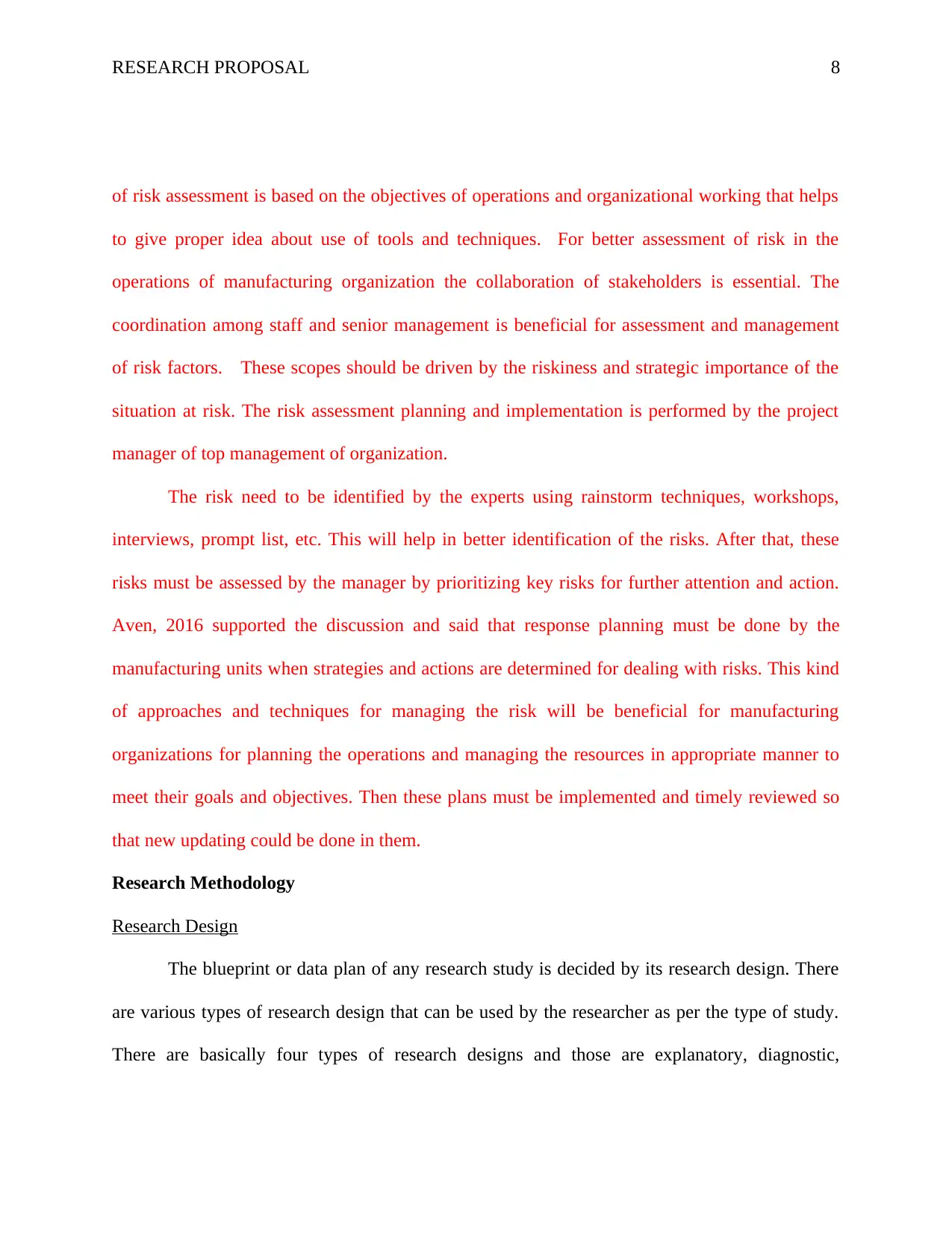
RESEARCH PROPOSAL 8
of risk assessment is based on the objectives of operations and organizational working that helps
to give proper idea about use of tools and techniques. For better assessment of risk in the
operations of manufacturing organization the collaboration of stakeholders is essential. The
coordination among staff and senior management is beneficial for assessment and management
of risk factors. These scopes should be driven by the riskiness and strategic importance of the
situation at risk. The risk assessment planning and implementation is performed by the project
manager of top management of organization.
The risk need to be identified by the experts using rainstorm techniques, workshops,
interviews, prompt list, etc. This will help in better identification of the risks. After that, these
risks must be assessed by the manager by prioritizing key risks for further attention and action.
Aven, 2016 supported the discussion and said that response planning must be done by the
manufacturing units when strategies and actions are determined for dealing with risks. This kind
of approaches and techniques for managing the risk will be beneficial for manufacturing
organizations for planning the operations and managing the resources in appropriate manner to
meet their goals and objectives. Then these plans must be implemented and timely reviewed so
that new updating could be done in them.
Research Methodology
Research Design
The blueprint or data plan of any research study is decided by its research design. There
are various types of research design that can be used by the researcher as per the type of study.
There are basically four types of research designs and those are explanatory, diagnostic,
of risk assessment is based on the objectives of operations and organizational working that helps
to give proper idea about use of tools and techniques. For better assessment of risk in the
operations of manufacturing organization the collaboration of stakeholders is essential. The
coordination among staff and senior management is beneficial for assessment and management
of risk factors. These scopes should be driven by the riskiness and strategic importance of the
situation at risk. The risk assessment planning and implementation is performed by the project
manager of top management of organization.
The risk need to be identified by the experts using rainstorm techniques, workshops,
interviews, prompt list, etc. This will help in better identification of the risks. After that, these
risks must be assessed by the manager by prioritizing key risks for further attention and action.
Aven, 2016 supported the discussion and said that response planning must be done by the
manufacturing units when strategies and actions are determined for dealing with risks. This kind
of approaches and techniques for managing the risk will be beneficial for manufacturing
organizations for planning the operations and managing the resources in appropriate manner to
meet their goals and objectives. Then these plans must be implemented and timely reviewed so
that new updating could be done in them.
Research Methodology
Research Design
The blueprint or data plan of any research study is decided by its research design. There
are various types of research design that can be used by the researcher as per the type of study.
There are basically four types of research designs and those are explanatory, diagnostic,
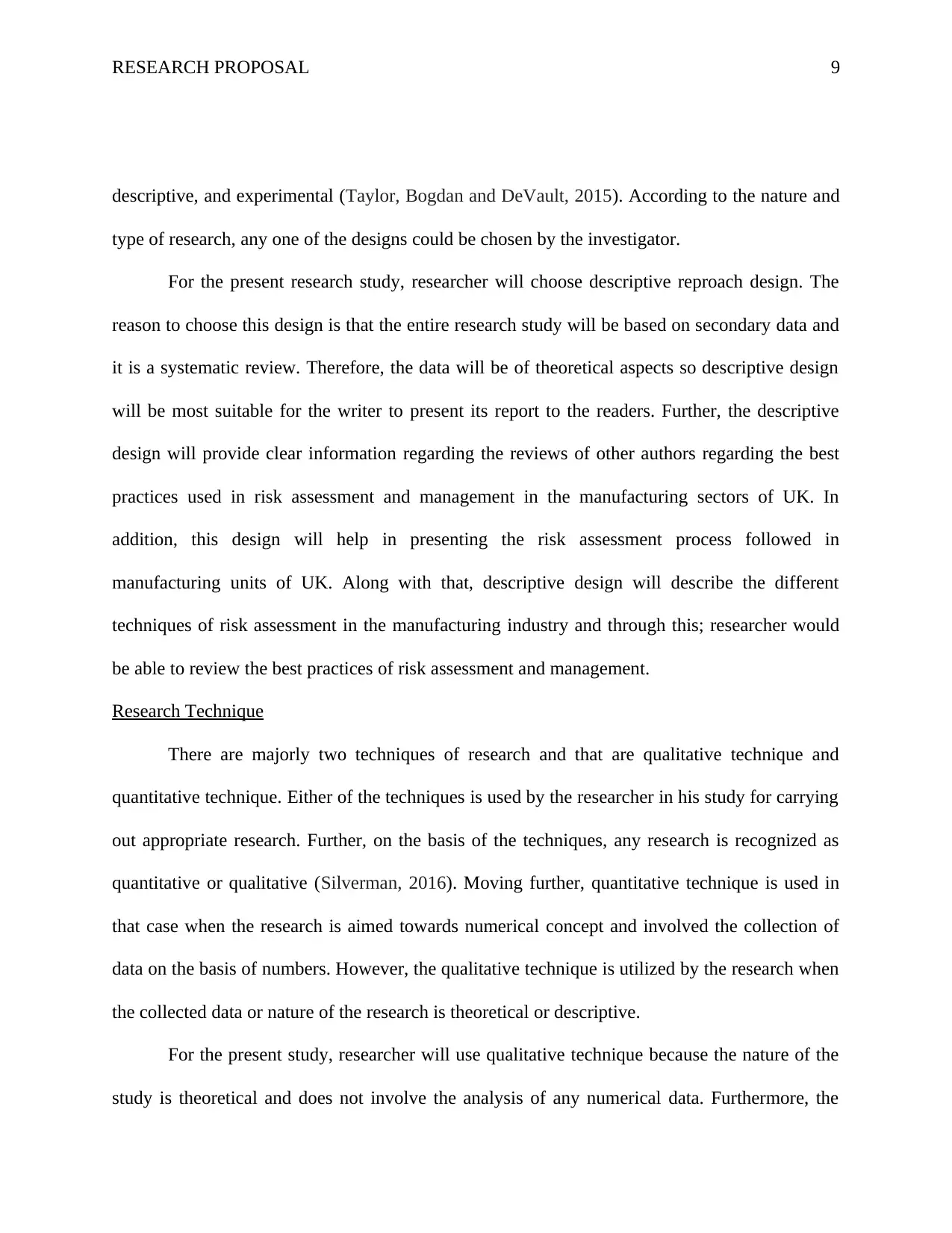
RESEARCH PROPOSAL 9
descriptive, and experimental (Taylor, Bogdan and DeVault, 2015). According to the nature and
type of research, any one of the designs could be chosen by the investigator.
For the present research study, researcher will choose descriptive reproach design. The
reason to choose this design is that the entire research study will be based on secondary data and
it is a systematic review. Therefore, the data will be of theoretical aspects so descriptive design
will be most suitable for the writer to present its report to the readers. Further, the descriptive
design will provide clear information regarding the reviews of other authors regarding the best
practices used in risk assessment and management in the manufacturing sectors of UK. In
addition, this design will help in presenting the risk assessment process followed in
manufacturing units of UK. Along with that, descriptive design will describe the different
techniques of risk assessment in the manufacturing industry and through this; researcher would
be able to review the best practices of risk assessment and management.
Research Technique
There are majorly two techniques of research and that are qualitative technique and
quantitative technique. Either of the techniques is used by the researcher in his study for carrying
out appropriate research. Further, on the basis of the techniques, any research is recognized as
quantitative or qualitative (Silverman, 2016). Moving further, quantitative technique is used in
that case when the research is aimed towards numerical concept and involved the collection of
data on the basis of numbers. However, the qualitative technique is utilized by the research when
the collected data or nature of the research is theoretical or descriptive.
For the present study, researcher will use qualitative technique because the nature of the
study is theoretical and does not involve the analysis of any numerical data. Furthermore, the
descriptive, and experimental (Taylor, Bogdan and DeVault, 2015). According to the nature and
type of research, any one of the designs could be chosen by the investigator.
For the present research study, researcher will choose descriptive reproach design. The
reason to choose this design is that the entire research study will be based on secondary data and
it is a systematic review. Therefore, the data will be of theoretical aspects so descriptive design
will be most suitable for the writer to present its report to the readers. Further, the descriptive
design will provide clear information regarding the reviews of other authors regarding the best
practices used in risk assessment and management in the manufacturing sectors of UK. In
addition, this design will help in presenting the risk assessment process followed in
manufacturing units of UK. Along with that, descriptive design will describe the different
techniques of risk assessment in the manufacturing industry and through this; researcher would
be able to review the best practices of risk assessment and management.
Research Technique
There are majorly two techniques of research and that are qualitative technique and
quantitative technique. Either of the techniques is used by the researcher in his study for carrying
out appropriate research. Further, on the basis of the techniques, any research is recognized as
quantitative or qualitative (Silverman, 2016). Moving further, quantitative technique is used in
that case when the research is aimed towards numerical concept and involved the collection of
data on the basis of numbers. However, the qualitative technique is utilized by the research when
the collected data or nature of the research is theoretical or descriptive.
For the present study, researcher will use qualitative technique because the nature of the
study is theoretical and does not involve the analysis of any numerical data. Furthermore, the
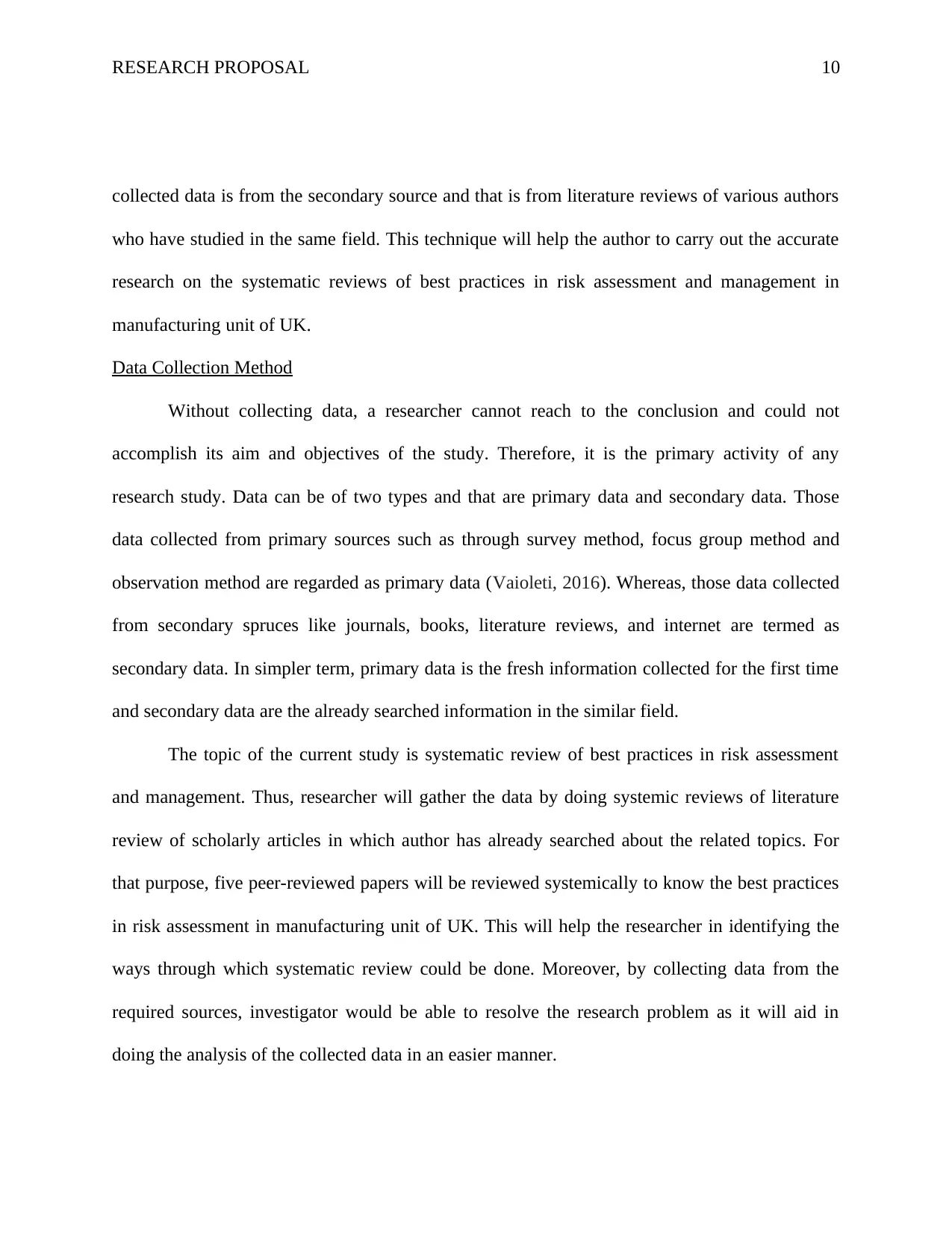
RESEARCH PROPOSAL 10
collected data is from the secondary source and that is from literature reviews of various authors
who have studied in the same field. This technique will help the author to carry out the accurate
research on the systematic reviews of best practices in risk assessment and management in
manufacturing unit of UK.
Data Collection Method
Without collecting data, a researcher cannot reach to the conclusion and could not
accomplish its aim and objectives of the study. Therefore, it is the primary activity of any
research study. Data can be of two types and that are primary data and secondary data. Those
data collected from primary sources such as through survey method, focus group method and
observation method are regarded as primary data (Vaioleti, 2016). Whereas, those data collected
from secondary spruces like journals, books, literature reviews, and internet are termed as
secondary data. In simpler term, primary data is the fresh information collected for the first time
and secondary data are the already searched information in the similar field.
The topic of the current study is systematic review of best practices in risk assessment
and management. Thus, researcher will gather the data by doing systemic reviews of literature
review of scholarly articles in which author has already searched about the related topics. For
that purpose, five peer-reviewed papers will be reviewed systemically to know the best practices
in risk assessment in manufacturing unit of UK. This will help the researcher in identifying the
ways through which systematic review could be done. Moreover, by collecting data from the
required sources, investigator would be able to resolve the research problem as it will aid in
doing the analysis of the collected data in an easier manner.
collected data is from the secondary source and that is from literature reviews of various authors
who have studied in the same field. This technique will help the author to carry out the accurate
research on the systematic reviews of best practices in risk assessment and management in
manufacturing unit of UK.
Data Collection Method
Without collecting data, a researcher cannot reach to the conclusion and could not
accomplish its aim and objectives of the study. Therefore, it is the primary activity of any
research study. Data can be of two types and that are primary data and secondary data. Those
data collected from primary sources such as through survey method, focus group method and
observation method are regarded as primary data (Vaioleti, 2016). Whereas, those data collected
from secondary spruces like journals, books, literature reviews, and internet are termed as
secondary data. In simpler term, primary data is the fresh information collected for the first time
and secondary data are the already searched information in the similar field.
The topic of the current study is systematic review of best practices in risk assessment
and management. Thus, researcher will gather the data by doing systemic reviews of literature
review of scholarly articles in which author has already searched about the related topics. For
that purpose, five peer-reviewed papers will be reviewed systemically to know the best practices
in risk assessment in manufacturing unit of UK. This will help the researcher in identifying the
ways through which systematic review could be done. Moreover, by collecting data from the
required sources, investigator would be able to resolve the research problem as it will aid in
doing the analysis of the collected data in an easier manner.
Secure Best Marks with AI Grader
Need help grading? Try our AI Grader for instant feedback on your assignments.
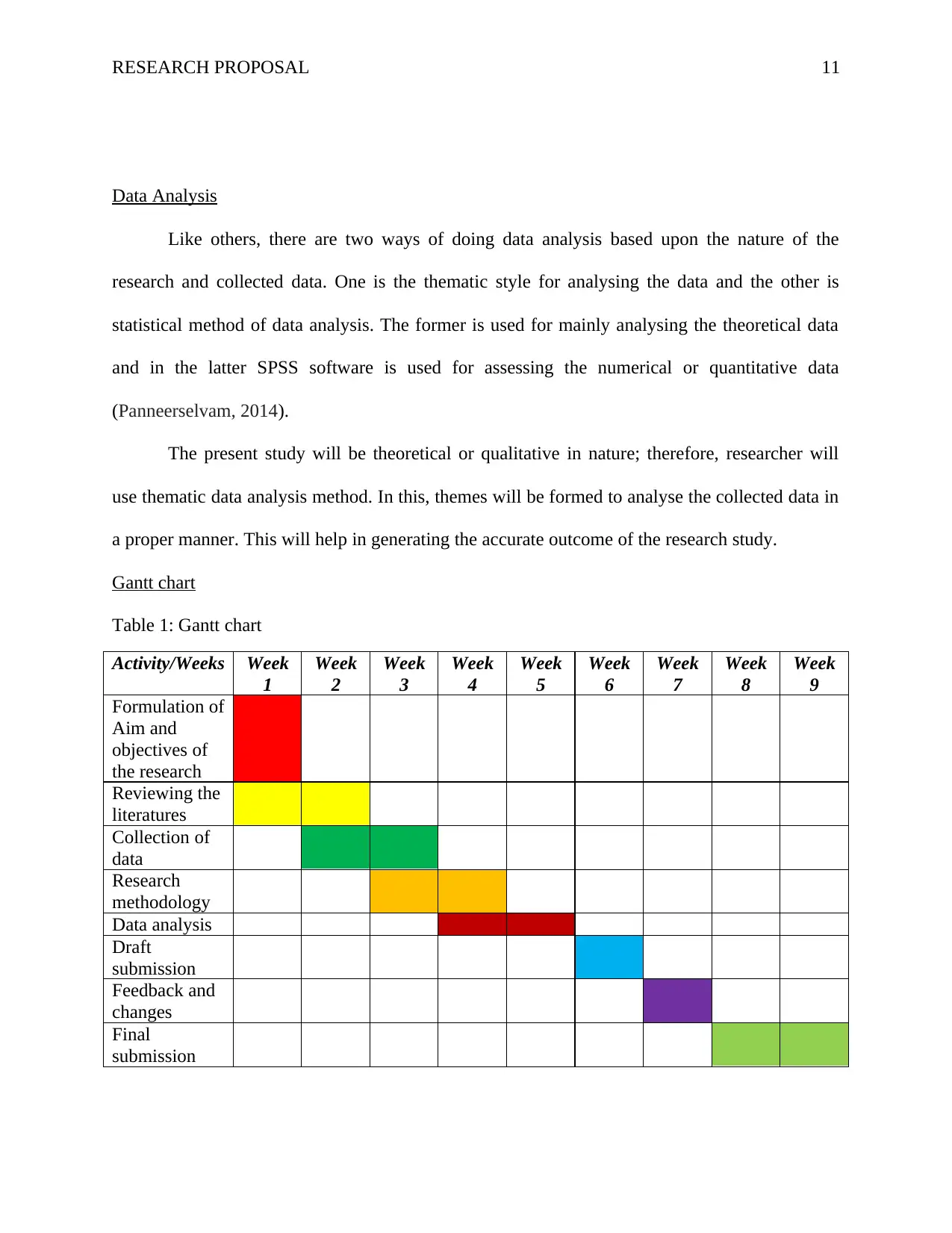
RESEARCH PROPOSAL 11
Data Analysis
Like others, there are two ways of doing data analysis based upon the nature of the
research and collected data. One is the thematic style for analysing the data and the other is
statistical method of data analysis. The former is used for mainly analysing the theoretical data
and in the latter SPSS software is used for assessing the numerical or quantitative data
(Panneerselvam, 2014).
The present study will be theoretical or qualitative in nature; therefore, researcher will
use thematic data analysis method. In this, themes will be formed to analyse the collected data in
a proper manner. This will help in generating the accurate outcome of the research study.
Gantt chart
Table 1: Gantt chart
Activity/Weeks Week
1
Week
2
Week
3
Week
4
Week
5
Week
6
Week
7
Week
8
Week
9
Formulation of
Aim and
objectives of
the research
Reviewing the
literatures
Collection of
data
Research
methodology
Data analysis
Draft
submission
Feedback and
changes
Final
submission
Data Analysis
Like others, there are two ways of doing data analysis based upon the nature of the
research and collected data. One is the thematic style for analysing the data and the other is
statistical method of data analysis. The former is used for mainly analysing the theoretical data
and in the latter SPSS software is used for assessing the numerical or quantitative data
(Panneerselvam, 2014).
The present study will be theoretical or qualitative in nature; therefore, researcher will
use thematic data analysis method. In this, themes will be formed to analyse the collected data in
a proper manner. This will help in generating the accurate outcome of the research study.
Gantt chart
Table 1: Gantt chart
Activity/Weeks Week
1
Week
2
Week
3
Week
4
Week
5
Week
6
Week
7
Week
8
Week
9
Formulation of
Aim and
objectives of
the research
Reviewing the
literatures
Collection of
data
Research
methodology
Data analysis
Draft
submission
Feedback and
changes
Final
submission
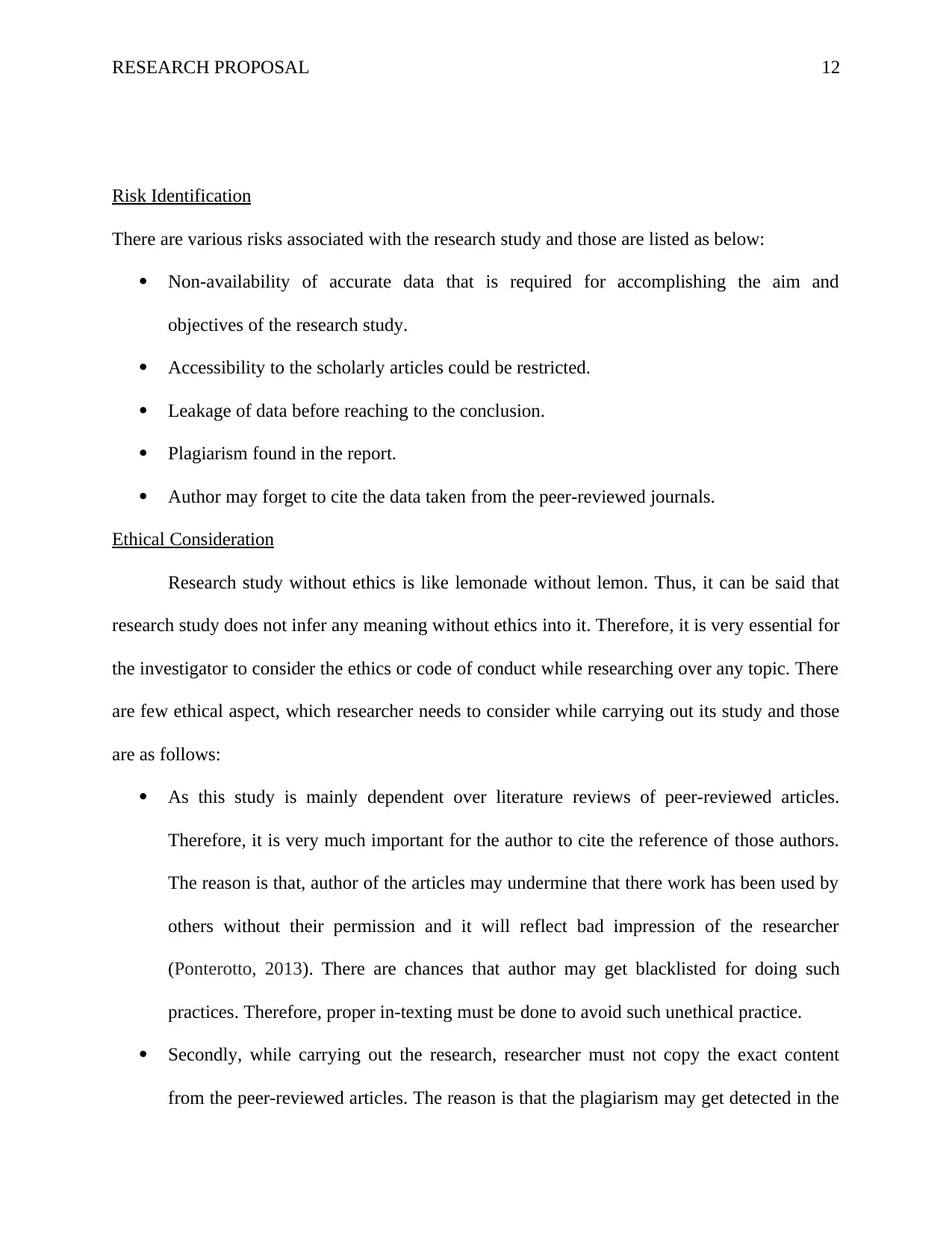
RESEARCH PROPOSAL 12
Risk Identification
There are various risks associated with the research study and those are listed as below:
Non-availability of accurate data that is required for accomplishing the aim and
objectives of the research study.
Accessibility to the scholarly articles could be restricted.
Leakage of data before reaching to the conclusion.
Plagiarism found in the report.
Author may forget to cite the data taken from the peer-reviewed journals.
Ethical Consideration
Research study without ethics is like lemonade without lemon. Thus, it can be said that
research study does not infer any meaning without ethics into it. Therefore, it is very essential for
the investigator to consider the ethics or code of conduct while researching over any topic. There
are few ethical aspect, which researcher needs to consider while carrying out its study and those
are as follows:
As this study is mainly dependent over literature reviews of peer-reviewed articles.
Therefore, it is very much important for the author to cite the reference of those authors.
The reason is that, author of the articles may undermine that there work has been used by
others without their permission and it will reflect bad impression of the researcher
(Ponterotto, 2013). There are chances that author may get blacklisted for doing such
practices. Therefore, proper in-texting must be done to avoid such unethical practice.
Secondly, while carrying out the research, researcher must not copy the exact content
from the peer-reviewed articles. The reason is that the plagiarism may get detected in the
Risk Identification
There are various risks associated with the research study and those are listed as below:
Non-availability of accurate data that is required for accomplishing the aim and
objectives of the research study.
Accessibility to the scholarly articles could be restricted.
Leakage of data before reaching to the conclusion.
Plagiarism found in the report.
Author may forget to cite the data taken from the peer-reviewed journals.
Ethical Consideration
Research study without ethics is like lemonade without lemon. Thus, it can be said that
research study does not infer any meaning without ethics into it. Therefore, it is very essential for
the investigator to consider the ethics or code of conduct while researching over any topic. There
are few ethical aspect, which researcher needs to consider while carrying out its study and those
are as follows:
As this study is mainly dependent over literature reviews of peer-reviewed articles.
Therefore, it is very much important for the author to cite the reference of those authors.
The reason is that, author of the articles may undermine that there work has been used by
others without their permission and it will reflect bad impression of the researcher
(Ponterotto, 2013). There are chances that author may get blacklisted for doing such
practices. Therefore, proper in-texting must be done to avoid such unethical practice.
Secondly, while carrying out the research, researcher must not copy the exact content
from the peer-reviewed articles. The reason is that the plagiarism may get detected in the
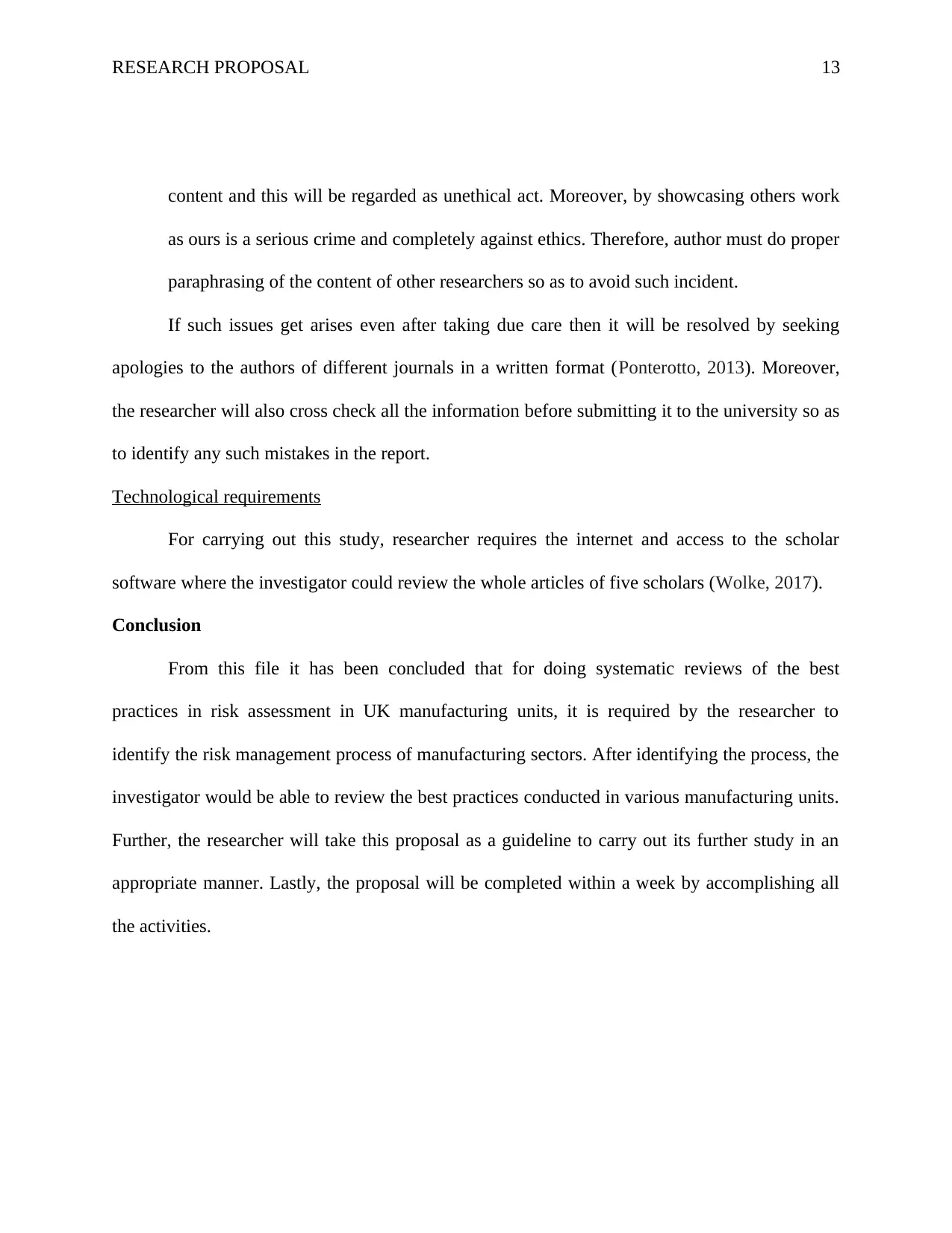
RESEARCH PROPOSAL 13
content and this will be regarded as unethical act. Moreover, by showcasing others work
as ours is a serious crime and completely against ethics. Therefore, author must do proper
paraphrasing of the content of other researchers so as to avoid such incident.
If such issues get arises even after taking due care then it will be resolved by seeking
apologies to the authors of different journals in a written format (Ponterotto, 2013). Moreover,
the researcher will also cross check all the information before submitting it to the university so as
to identify any such mistakes in the report.
Technological requirements
For carrying out this study, researcher requires the internet and access to the scholar
software where the investigator could review the whole articles of five scholars (Wolke, 2017).
Conclusion
From this file it has been concluded that for doing systematic reviews of the best
practices in risk assessment in UK manufacturing units, it is required by the researcher to
identify the risk management process of manufacturing sectors. After identifying the process, the
investigator would be able to review the best practices conducted in various manufacturing units.
Further, the researcher will take this proposal as a guideline to carry out its further study in an
appropriate manner. Lastly, the proposal will be completed within a week by accomplishing all
the activities.
content and this will be regarded as unethical act. Moreover, by showcasing others work
as ours is a serious crime and completely against ethics. Therefore, author must do proper
paraphrasing of the content of other researchers so as to avoid such incident.
If such issues get arises even after taking due care then it will be resolved by seeking
apologies to the authors of different journals in a written format (Ponterotto, 2013). Moreover,
the researcher will also cross check all the information before submitting it to the university so as
to identify any such mistakes in the report.
Technological requirements
For carrying out this study, researcher requires the internet and access to the scholar
software where the investigator could review the whole articles of five scholars (Wolke, 2017).
Conclusion
From this file it has been concluded that for doing systematic reviews of the best
practices in risk assessment in UK manufacturing units, it is required by the researcher to
identify the risk management process of manufacturing sectors. After identifying the process, the
investigator would be able to review the best practices conducted in various manufacturing units.
Further, the researcher will take this proposal as a guideline to carry out its further study in an
appropriate manner. Lastly, the proposal will be completed within a week by accomplishing all
the activities.
Paraphrase This Document
Need a fresh take? Get an instant paraphrase of this document with our AI Paraphraser
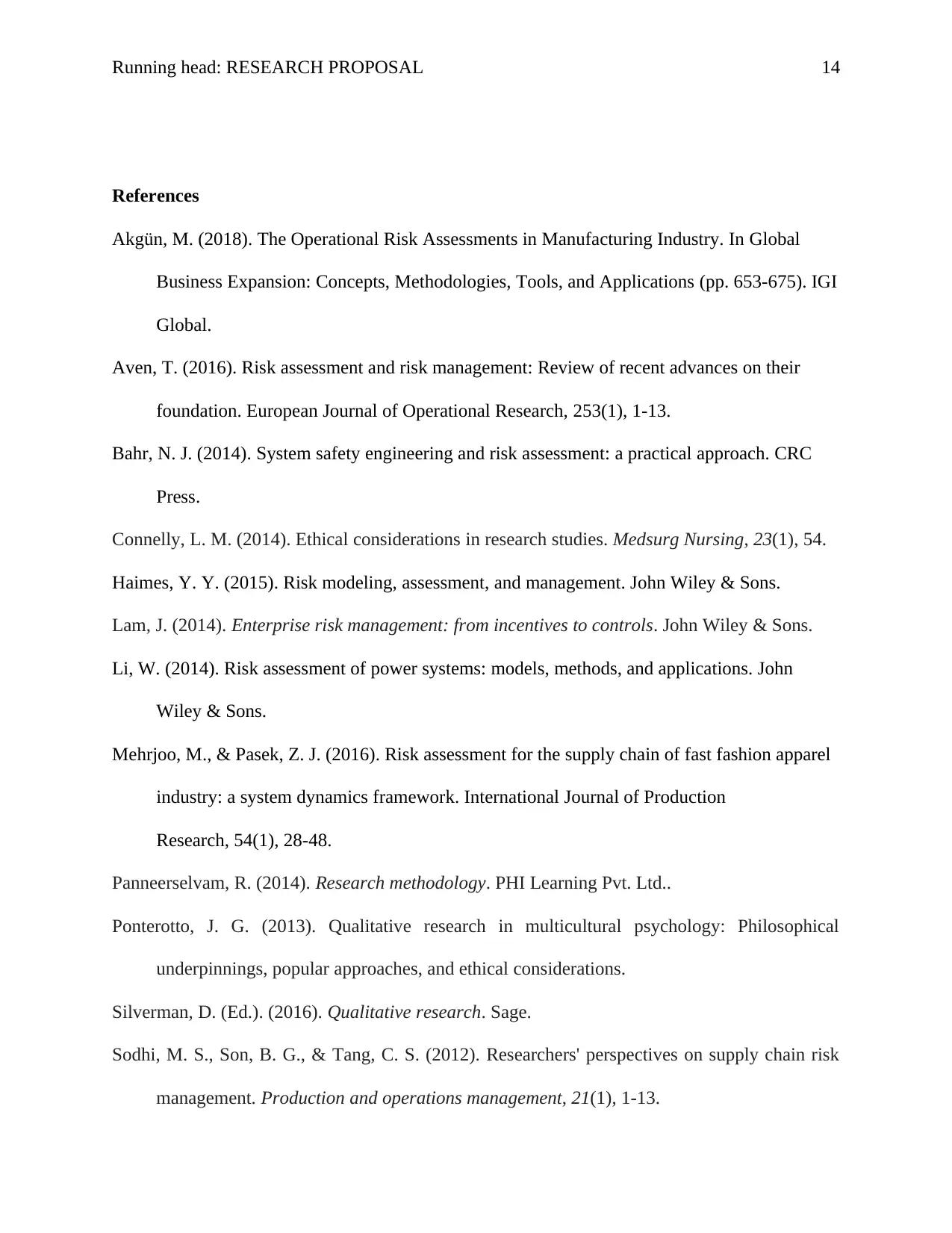
Running head: RESEARCH PROPOSAL 14
References
Akgün, M. (2018). The Operational Risk Assessments in Manufacturing Industry. In Global
Business Expansion: Concepts, Methodologies, Tools, and Applications (pp. 653-675). IGI
Global.
Aven, T. (2016). Risk assessment and risk management: Review of recent advances on their
foundation. European Journal of Operational Research, 253(1), 1-13.
Bahr, N. J. (2014). System safety engineering and risk assessment: a practical approach. CRC
Press.
Connelly, L. M. (2014). Ethical considerations in research studies. Medsurg Nursing, 23(1), 54.
Haimes, Y. Y. (2015). Risk modeling, assessment, and management. John Wiley & Sons.
Lam, J. (2014). Enterprise risk management: from incentives to controls. John Wiley & Sons.
Li, W. (2014). Risk assessment of power systems: models, methods, and applications. John
Wiley & Sons.
Mehrjoo, M., & Pasek, Z. J. (2016). Risk assessment for the supply chain of fast fashion apparel
industry: a system dynamics framework. International Journal of Production
Research, 54(1), 28-48.
Panneerselvam, R. (2014). Research methodology. PHI Learning Pvt. Ltd..
Ponterotto, J. G. (2013). Qualitative research in multicultural psychology: Philosophical
underpinnings, popular approaches, and ethical considerations.
Silverman, D. (Ed.). (2016). Qualitative research. Sage.
Sodhi, M. S., Son, B. G., & Tang, C. S. (2012). Researchers' perspectives on supply chain risk
management. Production and operations management, 21(1), 1-13.
References
Akgün, M. (2018). The Operational Risk Assessments in Manufacturing Industry. In Global
Business Expansion: Concepts, Methodologies, Tools, and Applications (pp. 653-675). IGI
Global.
Aven, T. (2016). Risk assessment and risk management: Review of recent advances on their
foundation. European Journal of Operational Research, 253(1), 1-13.
Bahr, N. J. (2014). System safety engineering and risk assessment: a practical approach. CRC
Press.
Connelly, L. M. (2014). Ethical considerations in research studies. Medsurg Nursing, 23(1), 54.
Haimes, Y. Y. (2015). Risk modeling, assessment, and management. John Wiley & Sons.
Lam, J. (2014). Enterprise risk management: from incentives to controls. John Wiley & Sons.
Li, W. (2014). Risk assessment of power systems: models, methods, and applications. John
Wiley & Sons.
Mehrjoo, M., & Pasek, Z. J. (2016). Risk assessment for the supply chain of fast fashion apparel
industry: a system dynamics framework. International Journal of Production
Research, 54(1), 28-48.
Panneerselvam, R. (2014). Research methodology. PHI Learning Pvt. Ltd..
Ponterotto, J. G. (2013). Qualitative research in multicultural psychology: Philosophical
underpinnings, popular approaches, and ethical considerations.
Silverman, D. (Ed.). (2016). Qualitative research. Sage.
Sodhi, M. S., Son, B. G., & Tang, C. S. (2012). Researchers' perspectives on supply chain risk
management. Production and operations management, 21(1), 1-13.
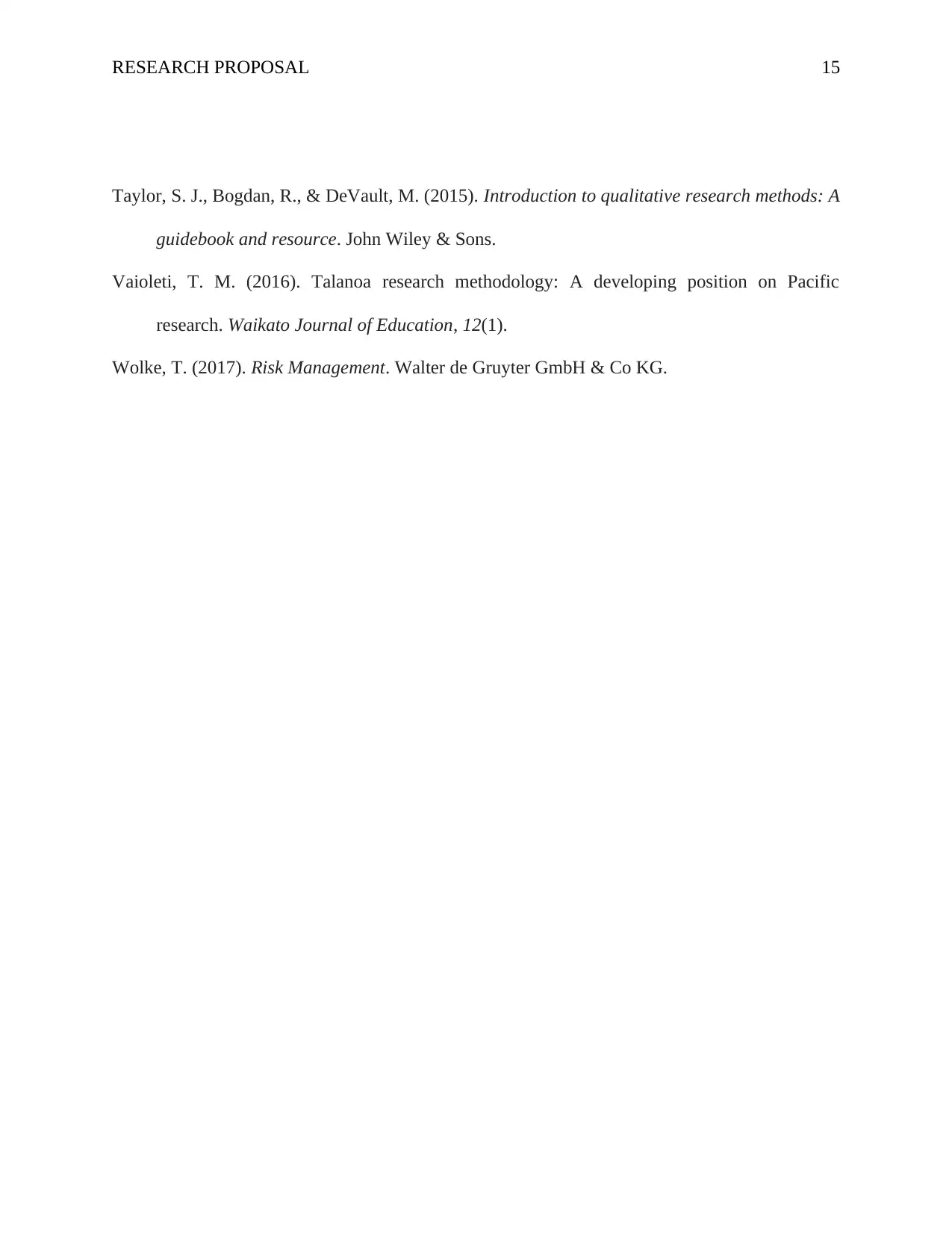
RESEARCH PROPOSAL 15
Taylor, S. J., Bogdan, R., & DeVault, M. (2015). Introduction to qualitative research methods: A
guidebook and resource. John Wiley & Sons.
Vaioleti, T. M. (2016). Talanoa research methodology: A developing position on Pacific
research. Waikato Journal of Education, 12(1).
Wolke, T. (2017). Risk Management. Walter de Gruyter GmbH & Co KG.
Taylor, S. J., Bogdan, R., & DeVault, M. (2015). Introduction to qualitative research methods: A
guidebook and resource. John Wiley & Sons.
Vaioleti, T. M. (2016). Talanoa research methodology: A developing position on Pacific
research. Waikato Journal of Education, 12(1).
Wolke, T. (2017). Risk Management. Walter de Gruyter GmbH & Co KG.
1 out of 15
![[object Object]](/_next/static/media/star-bottom.7253800d.svg)





